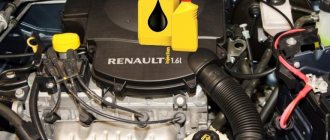February 17, 2015 Lada.Online 431 609 31
Depending on the year of manufacture, the Largus may be equipped with a Renault or VAZ engine. Currently, only domestic engines are installed on this car. Let's take a closer look at the technical characteristics of Lada Largus engines, as well as the features of their assembly.
- Renault-Nissan K7M
(8 valves) with a volume of 1.6 liters is capable of developing a power of 84 hp. This motor is installed on the “standard” and “norm” configurations. - Renault-Nissan K4M
(16 valves) is slightly more powerful, also 1.6 liters, but has a power of 105 hp. or 77 kW. The motor is provided for the “luxury” configuration. - VAZ 11189
(1.6 liter, 87 hp, 8 valves) began to be installed instead of K7M in 2015. - VAZ 21129
(1.6 liter, 106 hp, 16 valves) began to be installed instead of Renault K4M in October 2021. - VAZ 11182
(1.6l., 90hp, 8kl) began to be installed on Largus FL from March 2021
Both are Renault Alliance engines. Since December 2015, AVTOVAZ began installing its 8-valve VAZ-11189 engine. You can get acquainted with its pros and cons from this review.
Both engines from Renault-Nissan are paired with a 5-speed manual transmission. At the moment, AVTOVAZ does not plan to equip the Lada Largus with an automatic transmission.
Lada Largus engines are distinguished by high elasticity, and the manual gearbox is distinguished by precise gear shifting. For dynamic acceleration and confident overtaking, the engine power is quite enough. Both Lada Largus engines comply with Euro 4 environmental requirements.
Depending on the vehicle configuration, there are several options for installing auxiliary equipment on the engine:
- car with non-power steering;
- car without power steering with air conditioning;
- vehicle with hydraulic power steering;
- car with hydraulic power steering and air conditioning.
Technical characteristics of Renault engines
| Options | Engine model | |
| RENAULT, K4M | RENAULT, K7M | |
| Injection type | Electronically controlled multipoint fuel injection | |
| Fuel type | Gasoline Premium-95 GOST 51105-97 | |
| Number and arrangement of cylinders | 4, in-line | |
| Number of valves | 16 | 8 |
| Cylinder operating order | 1-3-4-2 | |
| Direction of rotation of the crankshaft (camshaft drive side) | ||
| right | ||
| Cylinder diameter/piston stroke, mm | 79,5×80,5 | |
| Working volume, cm3 | 1598 | |
| Compression ratio | 9,8 | 9,5 |
| Toxicity standards | Euro 4 | |
| Power at 5500 rpm, kW (hp) | — | 62 (84) |
| Power at 5750 rpm, kW (hp) | 77 (105) | — |
| Maximum torque, N.m (at rpm) | 148 (3750) | 124 (3000) |
| Volume of oil poured into the engine lubrication system, including oil filter, l | 4,8 | 3,3 |
[Episode 42]Largus CROSS with updated engine
View and compare engines
closer: Help in buying a new car: .
The price of the LADA Largus with the new engine remained unchanged: the station wagon costs from 635,400 rubles, the van – from 609,800 rubles, the LADA Largus Cross version – from 689,900 rubles. This is the price of models without various discounts, with which the car will cost significantly less.
As for the features of Largus
with a power unit of 106 hp. (VAZ-21129), then about them is expanded.
Description of the K7M engine (Renault Logan/Sandero/Largus)
In 2010, the K7M 800 engine appeared, which replaced the K7M 710. No design changes occurred, except that the engine was strangled, bringing it up to the Euro-4 environmental standard, while the power decreased from 86 hp to 83 hp. With.
The disadvantages of the engine remain the same:
- high fuel consumption.
- At idle the speed often fluctuates.
- Every 20-30 thousand km the valves need to be adjusted.
- no hydraulic compensators.
- If the belt breaks, the valve bends; it is recommended to change the belt every 60 thousand km.
- crankshaft oil seal leaking.
- the engine is noisy.
- there are vibrations during operation.
If you look at the engine from the positive side, it is worth noting its high reliability; according to the passport, the engine life is about 400 thousand km, but in practice it is a little more.
K4M on Lada Largus Cross versus 8 valve
We have already said what engine is in the Lada Largus Cross - it is K4M. Now let’s study what its 8-valve “competitor” looks like. Until 2010, it developed 90 horsepower, and then, during the transition to the new Euro standard, the power decreased. But one graph has remained since then.
Torque chart for K7M
You can remember only two numbers - 105 and 121. This is how many newtons per meter the motor develops, if you look at the ends of the range 1000-2000.
Now let's look at a similar graph relating to the 16-valve. Here, even at one thousand rpm, the torque is 110 N*m. And two thousand corresponds to the numbers 135.
Torque chart for K4M
It turns out that the 16-valve engine will be more torquey even in the “lower” frequency range (1000-2000). Of course, this looks atypical.
The general rule is this: an 8-valve engine pulls better at the bottom, and a larger number of valves only produces high power. Here, as we see, the rule was broken. But it is broken for the benefit of the buyer.
Details about the 16-valve Cross engine
It is known that the Renault K4M engine exists in several versions. The best of them is 110-horsepower. We are talking about a motor with automatic phase control, invented by Renault many years ago. You can find such a motor under the hood of the Duster crossover.
This is what a timing belt corrector should look like
Almost the same motor, where the phase regulator was replaced with a regular gear, ended up under the hood of the Lada Largus. It develops 102 horsepower, and just like its 110-horsepower brother, it complies with Euro-5 standards.
We look at the engine on the Cross version from the inside
As already mentioned, the Lada Largus Cross engine can only develop 102 “power”. Here a regular gear is put on each of the shafts. Now, if there was a “regulator” on the right, the power would increase to 110.
ICE K4M, Largus family
The “phase regulator” itself is a complex and expensive unit. It is often damaged due to low-quality fuels and lubricants. In general, VAZ designers decided not to take risks, protecting the consumer in advance. No unnecessary details - no problems. Normal logic.
According to the regulations, the “phase regulator” is supposed to be changed every 120,000 km. And the cost of this part exceeds the price of 10 timing belts. Such a “Cross” - who in Russia would need it?
The main “plus” of the K4M engine is its hydraulic compensators. 8-valve engines have nothing like that.
Here's a "hydrik" and a "hydrik"!
The number of compensators is 16, and they make the operation of the motor almost inaudible. Moreover, this is done in any of the modes - even at low speeds under load. But the crossover, in theory, should just “make noise” - there is nothing strange about that. However, preference was given to the 16-valve engine model. Whether this is good or bad, the buyer will decide.
If the timing belt breaks, each of the two engines – both K4M and K7M – will bend its valves. There is parity between them. In other respects, the 8-valve model turns out to be worse. But maybe the reader has a different opinion on this matter. Then share it with us.
Description of the K4M engine (Renault Logan/Sandero/Largus)
It is a development of the K7M series, with a new cylinder head, already 16 valve. There are many differences: K4M is quieter, it is more economical, there are no vibrations and many other advantages.
Motor disadvantages:
- expensive spare parts.
- If the belt breaks, the valve bends; it is recommended to change the belt every 60 thousand km.
- there are failures in work.
- Low-quality fuel causes the revs to fluctuate.
- troit (most often the problem is in the ignition coil, injectors or spark plugs).
- Unstable operation and floating speed are usually caused by the crankshaft position sensor or ignition coil.
If you choose between K7M and K4M, then the choice should definitely remain with the more modern and practical K4M.
What engines are suitable for Largus?
What oil is better to fill in Lada Largus with internal combustion engine 21129 2018?
You can fill in the “factory” Elf Solaris Rnx 5w30
Or, on the recommendation of Renault (since many components are from the Renault-Nissan center) Shell PC 1448 0W30, PC 1021 0W30, Lukoil Genesis RN 5W40
6 Good answer
Is it worth taking the Lada Vesta? Is this a good car?
It all depends on your expectations and financial capabilities, when compared with luxury foreign cars, which are 5 times more expensive, of course the Lada Vesta will lose in all respects, but if we consider cars up to 1 million rubles, then among its competitors it stands out noticeably in design and is not inferior in comfort !
3 3 · Good answer
When will the timing belt be replaced on a Largus 16 valve?
According to the operating rules of the Largus 1.6 16V car, the timing belt must be changed after 60 thousand kilometers or after 4 years, whichever comes first. It is clear that many car owners violate these deadlines at their own peril and risk. The cost of replacement is from 1500 to 3000. This is a small amount compared to the consequences of a broken timing belt.
2 Good answer
What is the difference between the ZMZ 40630s engine and the 40630a engine?
The 40630C engine has a power of 130 hp, while the 40630A engine was positioned as an “economy” with a power of 98 hp. Significant savings are obtained not so much due to reduced fuel consumption, but due to significantly lower taxes, because an engine with index “A” falls into the “up to 100 hp” category, and there the tax is approximately 1.7-2.5 times less.
4 Good answer
Whose engine is Lada Largus
Previously, engines for Lada Largus came assembled from the Renault plant in Spain, but recently engines of the K4M series (16 valves, 105 hp) began to be assembled at AVTOVAZ. According to the director of the Power Units project, Francois Goujon, the quality of engines assembled at AVTOVAZ corresponds to the world level.
The AVTOVAZ press service assures that a quality system is used in the production of new engines to ensure that products comply with the international standards of the alliance. In addition to personnel training, it includes control on the production line, during which each assembled engine is tested in different modes on a special stand. The technology also provides for a weekly check, when one of the motors is completely disassembled and the quality of its assembly is analyzed.
Why it’s impossible to love the Lada Largus: the model’s disadvantages
To find out all the disadvantages of the Largus, we interviewed owners, studied user forums and, based on reviews, compiled a list of the car’s shortcomings.
Largus breeders have many questions regarding ergonomics. For example, the seat heating buttons are located in the “blind zone” next to the seat adjustment lever. For some reason, the joystick responsible for adjusting the side mirrors is located under the handbrake. The horn is hidden on the steering column lever. The electric windows were placed on the dashboard closer to the gearshift lever.
The interior is far from ideal: the materials used in the decoration are cheaper than the cheapest ones. The driver's seat and dashboard creaks from the factory.
The Largus salon is too ascetic. There is no heated windshield, steering wheel or rear seats, no modern multimedia, no good sound and no electronic assistants even in the options. Lada offers Largus buyers only heated front seats, an old radio, ABS and rear parking sensors.
About the domestic VAZ 11189 engine
In April 2021, AVTOVAZ began installing domestic VAZ 11189 engines on Largus. The advantages of this engine are described in one of the issues of “Okay Mechanics”.
| Some measurement results Autoreview | |||
| Options | Cars | ||
| Lada Largus (VAZ engine) | Lada Largus (Renault engine) | ||
| Maximum speed, km/h | 157,1/156,7* | 168,0/167,6 | |
| Acceleration time, s | 0—50 km/h | 4,3/4,8 | 3,9/4,4 |
| 0—100 km/h | 13,9/16,8 | 12,5/14,5 | |
| 0—150 km/h | 61,1/71,6 | 38,9/43,7 | |
| on the way 400 m | 19,3/20,2 | 18,4/19,4 | |
| on the way 1000 m | 36,1/37,8 | 34,1/36,0 | |
| 60-100 km/h (III) | 8,7/10,6 | 9,3/10,6 | |
| 60-100 km/h (IV) | 12,1/15,1 | 12,8/14,1 | |
| 80-120 km/h (V) | 19,3/24,0 | 22,1/23,4 | |
| * Partial load/full load | |||
| Engine characteristics | ||
| Options | VAZ-11189 | Renault K4M |
| Volume, cm3 | 1596 | 1598 |
| Number of valves | 8 | 16 |
| Maximum power, hp/kW/rpm | 87/64/5100 | 102/75/5750 |
| Maximum torque, Nm/rpm | 140/3800 | 145/3750 |
| Cylinder diameter/piston stroke, mm | 82,0/ 75,6 | 79,5/80,5 |
| Compression ratio | 10,3:1 | 9,8:1 |
| Injection type | distributed, electronically controlled | |
| Octane number of gasoline | at least 92 | not less than 95 |
Close-up view - K4M engine on video
Depending on the year of manufacture, the Largus may be equipped with a Renault or VAZ engine. Currently, only domestic engines are installed on this car. Let's take a closer look at the technical characteristics of Lada Largus engines, as well as the features of their assembly.
- Renault-Nissan K7M
(8 valves) with a volume of 1.6 liters is capable of developing a power of 84 hp. This motor is installed on the “standard” and “norm” configurations. - Renault-Nissan K4M
(16 valves) is slightly more powerful, with 105 hp. or 77 kW. The motor is provided for the “luxury” configuration. - VAZ 11189
(8 valve engine) began to be installed instead of K7M in 2015. - VAZ 21129
(16 valves) began to be installed instead of Renault K4M in October 2017.
New VAZ 11182 engine
At the beginning of 2021, AVTOVAZ introduced a new 8-valve 1.6-liter engine (VAZ 11182 or AR16SEg2), which first appeared on the Lada Largus FL and will later appear on the Lada Granta FL.
AVTOVAZ writes that the new engine featured an updated connecting rod and piston group, a modernized crankshaft and a gas distribution mechanism. As a result, power is increased to 90 hp, and 80% of torque is available from 1000 rpm, which reduces fuel consumption and reduces shift frequency. In addition, the need to adjust valves before a mileage of 90,000 kilometers is eliminated. The engine is adapted to run on gasoline with an octane rating of 92. Read more about the design in this review. Technical characteristics and reviews about it are at the link.
Let us remind you that you can read about the VAZ 21129 engine here.
Key words: Lada Largus engine
+23
Share on social networks:
Found an error? Select it and press Ctrl+Enter..
What is the reason for its popularity: the advantages of Lada Largus
There is no need to judge the appearance of the Largus: the current station wagon is a copy of the Dacia Duster MCV, originally from the early 2000s. AvtoVAZ designers did not bother to change the appearance of the model, but this did not scare off the target audience: practical drivers do not put design at the forefront.
The main trump cards of the domestic “heel” are capacity and price. From a car with a spacious trunk of more than 600 liters, the interior is transformed into a seven-seater car. And with two rows of seats folded, a fifth dimension opens up, containing almost 2.5 thousand liters of cargo! At the same time, the third row of seats is by no means just for show, like many crossovers.
Not only legless dwarfs, tiny animals or children will be able to sit comfortably in the last row. Even two adults of standard build and height can survive a long trip there, because a seven-seater cabin is needed not only by large families, but also by those who have many friends. And thanks to the rectangular shape of the body and interior trim without bevels, it is easy to carry long items in the trunk: boards, building materials, oversized cargo, etc. Practicality is the Largus’s ace in the hole.
Low cost is the second plus of the model. Maintenance costs are also low and spare parts are easy to find. Simple optics and a primitive design in this case play into the hands of the model. No matter how much journalists talk about how “Lada rises from its knees,” Togliatti has not yet learned how to assemble reliable automatic transmissions, let alone more complex and smart designs. Therefore, the simpler, the more reliable and cheaper.
Read also: How to make a linear output in a car radio
Another advantage of the model is its ground clearance. For the regular version of LADA Largus it reaches 170 mm, for the cross version - 200 mm.
Engine design 8 valves Lada Lagrus
If you have ever owned a VAZ car, then you can already imagine how the 8-valve VAZ Lada Largus engine works.
This is a cast iron block that resists wear well. Aluminum cylinder head and valve cover, as well as a pan made of steel.
Number of cylinders - 4, number of valves - 8.
The timing drive, traditionally for Russian front-wheel drive cars, is belt driven. This made it possible to reduce the noise of the engine, but at the same time reduced the life of the belt. Although replacing the Lada Largus timing belt and rollers is a simple procedure that can be performed even in any garage.
There are no hydraulic compensators in this engine. Their installation would have increased the cost of the design, so the factory abandoned them. Valve clearances are adjusted using special shims. This procedure should be carried out at least once every 30 thousand kilometers. In general, such work will not hit your pocket hard, since there are plenty of specialists, and adjusting washers are available in different sizes for quite reasonable money.
The intake manifold is plastic, the exhaust has a cat manifold. The throttle is electronic.
Injection - distributed through injectors in the fuel rail.
Plans to update the technical potential of Lada Largus
If you think that you should wait for the Largus engine lineup to be updated, and only then go to inspect the car in the showroom, you should find out a few not very pleasant facts about the future of the car. We are talking about new power units that were planned for the car quite a long time ago. Lada Largus behaves quite adequately with French power plants, but they have one big drawback - they are bought for dollars from a foreign manufacturer. This ties the VAZ company to the exchange rate in the country, and the price of the model begins to float along with the exchange rate. Therefore, the following innovations in the technical part of the machine were planned for 2015:
- addition of a new 1.8-liter domestically produced power plant to the car;
- the engine from Project-S has 122 horsepower and can be turbocharged to produce more power;
- there is another option for a new power plant - the well-known 1.5-liter unit with 87 horsepower, which is installed on the Grant;
- gearboxes will also be changed, which will migrate to Largus from other domestic models;
- most likely, the top-end 122-horsepower unit will be available for Largus Cross models and, possibly, the most expensive version of the 7-seater station wagon;
- in other options, old domestic developments will be used, adjusted to the requirements of the time;
- the concern will have to work with an 87-horsepower unit, because in 2021 it will no longer meet environmental requirements.
It must be said that the company has a lot of work, but there is practically no news about testing the updated machine. We only see old versions of Larugsa in official showrooms, which continue to rise in price as the exchange rate rises. I would like a domestic car to be stable in its value, otherwise the point of having a Russian brand of car production disappears. People always bought Lada for its affordability and satisfactory reliability. If both of these factors disappear, people will prefer Chinese cars for the same money. Moreover, today the Chinese market offers very impressive options for choosing a car at very affordable prices.











